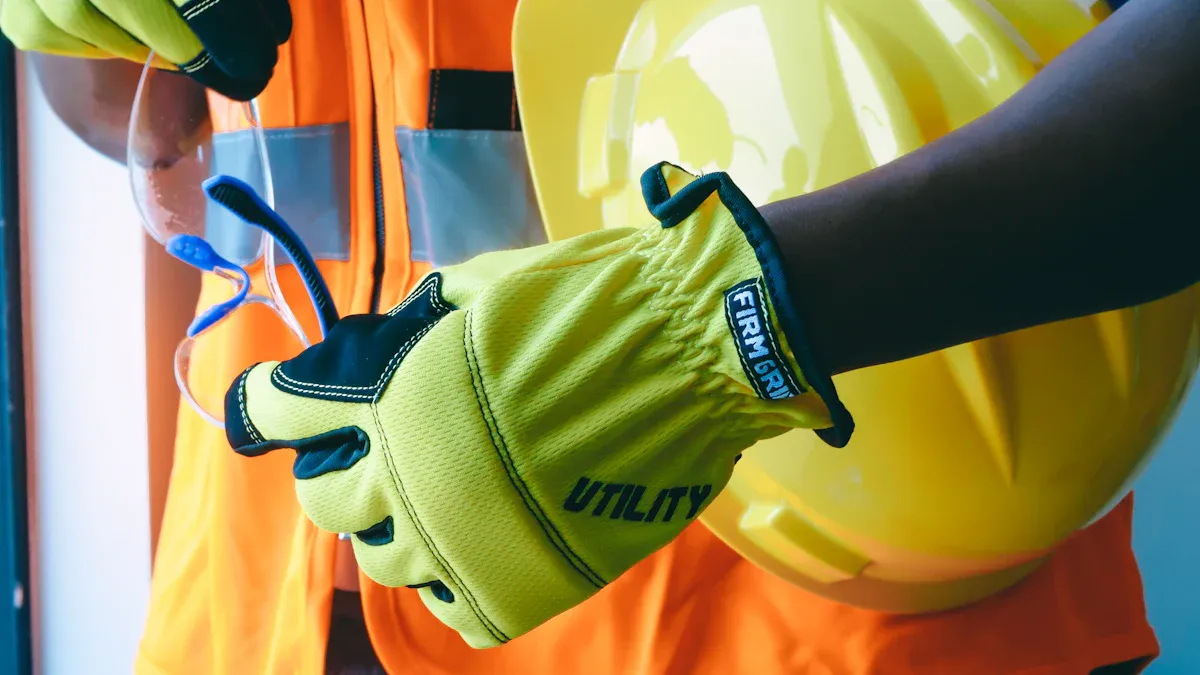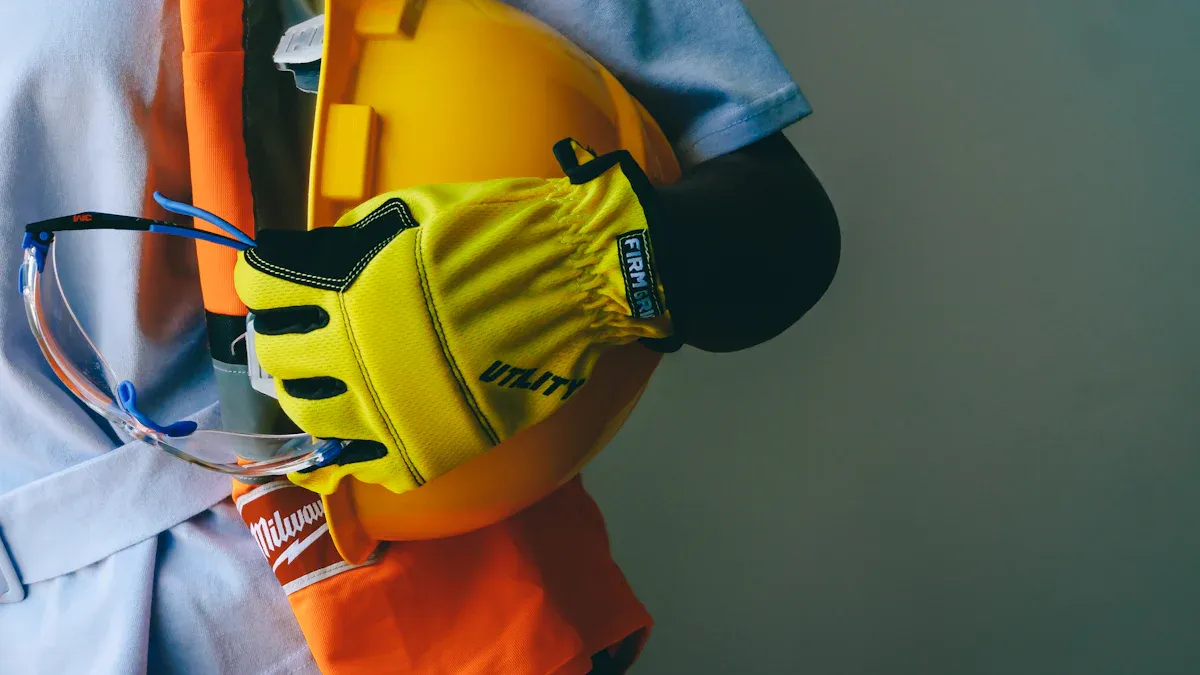
Quarry safety procedures play a vital role in protecting workers and preventing accidents. Each year, approximately 125 million cases of work-related injuries are reported globally. In quarries, these numbers can be alarming. Effective safety measures significantly reduce accident rates and create safer work environments. You must stay aware of specific safety protocols to safeguard yourself and your colleagues. Remember, one person dies every three minutes due to an accident or occupational disease. Prioritizing quarry health and safety can save lives.
Key Takeaways
Always wear the right personal protective equipment (PPE) to shield yourself from hazards. This includes helmets, gloves, and safety boots.
Report any hazards you see immediately to your supervisor. Quick reporting helps prevent accidents and keeps everyone safe.
Participate in regular safety training and drills. Staying informed about safety protocols reduces risks and prepares you for emergencies.
Conduct daily inspections of your PPE and equipment. Regular checks ensure everything is in good condition and ready for use.
Understand and follow the emergency response plan. Knowing what to do in an emergency can save lives and minimize injuries.
PPE Requirements

Types of PPE
In a quarry environment, wearing the right personal protective equipment (PPE) is crucial for your safety. Here are the essential types of PPE you should use:
Respirators
Hearing protection devices
Safety helmets
Eye and face protection
Safety boots
Gloves
Insulated jackets
Weatherproof coats
High-visibility vests
Each piece of equipment serves a specific purpose. For example, respirators protect you from inhaling harmful dust and fumes, while safety helmets shield your head from falling objects. Wearing the appropriate PPE helps you avoid serious injuries and health issues.
Proper Use
Using PPE correctly is just as important as having it. Here are some best practices to ensure you maximize the effectiveness of your protective equipment:
Inspect your PPE before each use to confirm it is in good condition.
Ensure a proper fit and secure fastening of all equipment.
Follow the manufacturer’s instructions for proper usage.
Clean and maintain your PPE according to guidelines.
Regular inspections are vital. Conduct daily visual checks to look for visible damage, fit, and functionality. Detailed inspections should follow the manufacturer’s recommendations, which may occur monthly or quarterly. An annual inspection plan helps ensure your PPE remains in good condition and is not expired.
Training plays a significant role in proper PPE use. Your training should cover PPE selection, fitting, inspection, maintenance, and replacement schedules. Regular refresher training sessions reinforce safe practices. Supervisors should conduct periodic safety audits to ensure compliance and foster a culture of safety awareness among workers.
Neglecting to wear appropriate PPE can lead to severe consequences. Studies show that workers who do not use protective measures are more likely to suffer from respiratory disorders and other health issues. For instance, one study found that quarry workers using protective measures are less likely to develop restrictive lung disorders compared to those who do not. This highlights the importance of adhering to quarry safety procedures and wearing the right protective equipment.
Hazard Reporting
Common Hazards
In a quarry, you face various hazards that can lead to serious injuries or even fatalities. Recognizing these hazards is crucial for your safety and the safety of your colleagues. Here are some common hazards you should be aware of:
Overheated machinery
Heat-related illnesses
Increased dust exposure
Public trespassing
Fire hazards due to dust buildup and overheated machinery
Safety failures related to blasting operations
These hazards can create dangerous situations if not addressed promptly. For instance, exposure to dust can lead to respiratory issues, while overheated machinery can cause fires or equipment failures.
Reporting Procedures
Immediate hazard reporting is essential in maintaining a safe work environment. When you identify a hazard, report it to your supervisor without delay. This action helps prevent accidents and ensures that necessary measures are taken to mitigate risks.
To enhance your hazard identification skills, follow these steps:
Observe: Regularly monitor your surroundings for potential hazards.
Document: Write down the details of the hazard, including its location and nature.
Report: Inform your supervisor or safety officer about the hazard as soon as possible.
Here’s a table summarizing the primary causes of injuries related to common hazards in quarries:
Hazard Type | Description | Impact on Injuries |
|---|---|---|
Dust | Exposure to airborne contaminants regulated by workplace standards. | Can lead to respiratory issues and other health problems. |
Noise | High levels from machinery causing hearing loss and increased accident risk. | Contributes to fatigue and reduced concentration, leading to injuries. |
Gas | Presence of toxic gases like carbon monoxide and methane. | Can cause respiratory problems and asphyxiation, leading to severe injuries or fatalities. |
By developing strong safety knowledge and practicing effective hazard reporting, you contribute to a safer quarry environment for everyone.
Emergency Procedures
Response Plan
An effective emergency response plan is essential for quarry workers. This plan outlines the steps to take during an emergency to ensure everyone’s safety. Here are the key components of a solid emergency response plan:
Contact Information for Key Personnel: Always have a list of emergency contacts readily available.
Clear Emergency Action Steps: Define specific actions for various emergency scenarios.
Floor Plans and Utility Shutoff Maps: Keep updated maps to help navigate the site during emergencies.
Site-Specific Risk Assessment: Identify potential risks unique to your quarry.
Defined Communication Protocols: Establish clear lines of communication for emergencies.
Ongoing Training and Drills: Regularly practice emergency procedures to stay prepared.
Vendor Agreements and Response Resources: Know who to contact for external support.
Post-Incident Recovery Planning: Have a plan for recovery after an emergency.
Conducting regular emergency drills is crucial. It is recommended to hold these drills quarterly. Involve all staff members and cover various emergency scenarios to ensure everyone knows their roles.
First Aid
First aid procedures are vital in responding to injuries that may occur in a quarry environment. Knowing how to act quickly can save lives. Here’s a table outlining critical first aid procedures for common injuries in quarries:
Type of Injury | First Aid Procedure |
|---|---|
Injuries from Accidents | Immobilize the injury, control bleeding, and provide initial pain relief. |
Respiratory Distress | Provide rescue breathing or use an AED. |
Chemical Exposure | Implement eye wash procedures and skin decontamination. |
Heat Exhaustion or Heat Stroke | Recognize symptoms and provide immediate care. |
Muscle Strains | Manage injuries and prevent further damage. |
Cardiac Emergencies | Train in CPR and use of an AED. |
Crush Injuries | Manage the injury and prevent shock until help arrives. |
Noise-Induced Hearing Loss | Manage sudden hearing loss incidents. |
Eye Injuries | Flush the eye with water and prevent further damage. |
Confined Space Emergencies | Provide initial resuscitation and prevent further harm. |
Supervisors and at least one employee on each crew must have a valid first-aid training certificate from recognized organizations, such as the American Red Cross or Mine Safety and Health Administration. This ensures that trained personnel are always available to respond to emergencies.
By understanding and implementing these emergency procedures, you contribute to a safer working environment for yourself and your fellow quarry workers.
Equipment Safety

Safe Operation
Operating machinery safely is crucial for quarry workers. You must follow specific safety protocols to minimize risks. Here are some essential practices for safe operation:
Safety Training: Ensure you receive proper training on equipment and safety procedures. Knowledgeable operators reduce the risk of accidents.
Use of PPE: Always wear personal protective equipment (PPE) to safeguard against potential hazards. This includes helmets, gloves, and eye protection.
Pre-Operation Checks: Conduct safety checks before using any machinery. Identify any issues that could lead to accidents.
Common causes of equipment-related accidents in quarries include:
Slips and trips
Contact with moving or falling objects
Falls from height
Handling issues
Moving machinery and drowning
By being aware of these risks, you can take proactive steps to ensure your safety and the safety of your colleagues.
Maintenance Checks
Regular maintenance checks are vital for keeping quarry equipment safe and operational. You should prioritize these checks to enhance safety and efficiency. Here are some key benefits of routine maintenance:
Minimized Risk: Regular checks reduce the risk of accidents and injuries by ensuring reliable machinery operation.
Increased Efficiency: Well-maintained equipment operates more efficiently, leading to higher output and better productivity.
Early Issue Identification: Preventive maintenance helps identify potential issues early, reducing the risk of major breakdowns and costly repairs.
Extended Lifespan: Routine checks and timely repairs extend the lifespan of your equipment, ultimately lowering replacement costs.
During inspections, pay attention to common maintenance issues. Here’s a table summarizing some frequent problems:
Maintenance Issue | Description |
|---|---|
Safety incidents | Poorly maintained equipment can lead to accidents and injuries. |
Regulatory penalties | Neglected repairs may result in fines or stop-work orders from regulators. |
Higher long-term costs | Equipment wears out faster without proper maintenance, leading to early replacement. |
Reputation damage | Frequent disruptions from preventable failures can harm your operation’s reputation. |
By adhering to these equipment safety practices, you contribute to a safer working environment for yourself and your fellow quarry workers.
Training and Safety Meetings
Safety Training
Safety training is essential for quarry workers. It equips you with the knowledge and skills needed to work safely in a hazardous environment. Effective training programs cover various critical topics, including:
Fall protection
Excavation safety
Electrical safety
Hazard communication
Fire safety
Chemical safety
Heat stress prevention
Cold weather safety
Machine guarding
Confined spaces
Respiratory protection
Emergency procedures
Workplace violence prevention
These topics help you understand the risks associated with quarry work and how to mitigate them. Regular safety training ensures you stay updated on the latest safety regulations and practices. This ongoing education fosters a culture of safety, where you and your colleagues prioritize safe work habits.
Regular Meetings
Regular safety meetings play a vital role in maintaining a safe work environment. These meetings provide ongoing training and ensure that all quarry workers are well-informed about safety protocols. Here are some key benefits of holding regular safety meetings:
You learn to identify hazards through shared experiences and storytelling, enhancing awareness among coworkers.
Teamwork is emphasized, as collective responsibility for safety allows you to support each other in identifying hazards.
Effective communication among team members is crucial for maintaining safety during operations.
These meetings keep safety top of mind. They encourage you to share safety concerns and experiences, fostering a collaborative safety culture. Additionally, regular meetings address current safety issues, ensuring that all workers are informed and aligned on safety protocols.
By participating in safety training and regular meetings, you contribute to a safer quarry environment for yourself and your fellow workers.
Adhering to quarry safety procedures is critical for your well-being and that of your colleagues. You must take personal responsibility for your safety by following established guidelines and participating in training. Here are some effective methods to reinforce safety procedures among quarry workers:
Wear seat belts to ensure safety during collisions or tip-overs.
Ensure operator visibility to address issues caused by environmental factors.
Always wear personal protective equipment (PPE) as your first line of defense against hazards.
Adhere to legally required site-specific training to increase awareness of hazards.
Respect mobile equipment right of way to prevent accidents on site.
By committing to these practices, you contribute to a safer quarry environment. Remember, safety is a shared responsibility, and your actions can make a significant difference.
FAQ
What is the importance of PPE in a quarry?
Wearing PPE protects you from various hazards. It reduces the risk of occupational injuries and ensures your safety while working in a potentially dangerous environment.
How should I report hazards in the quarry?
You should report hazards immediately to your supervisor. Document the details, including location and nature, to help address the issue effectively.
What should I do in case of an emergency?
Follow your quarry’s emergency response plan. Ensure you know the contact information for key personnel and participate in regular drills to stay prepared.
How often should safety training occur?
Safety training should occur regularly, ideally quarterly. This ensures you stay updated on safety programs and best practices to minimize risks.
What are risk assessments, and why are they important?
Risk assessments identify potential hazards in the quarry. They help you understand risks and implement safety measures, reducing the likelihood of accidents and injuries.



